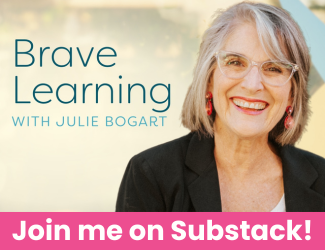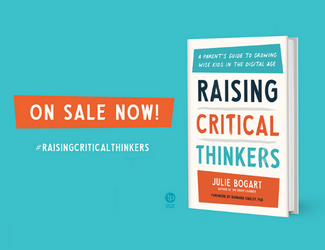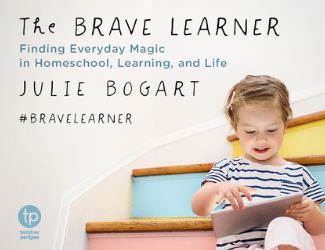Think of a regret. What do you wish you had done differently? Write about that.
Archive for January, 2010
Tuesday Teatime: History celebration
Dear Julie-
Here is a photo of our most recent Tea Time. My daughter Stefanie and I dressed up to celebrate the ending of our history unit study on the mid 1800s.
Blessings, Cindy Burban
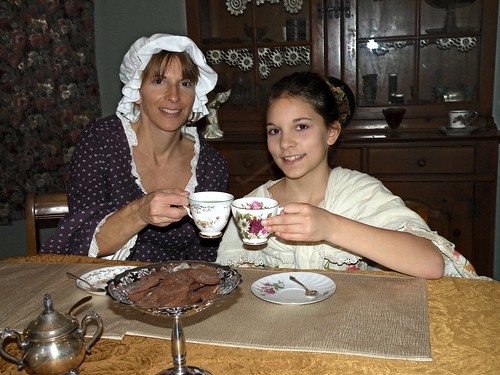
Friday Freewrite: What you own…
What is your most indispensable possession and why?
You gotta be home to homeschool
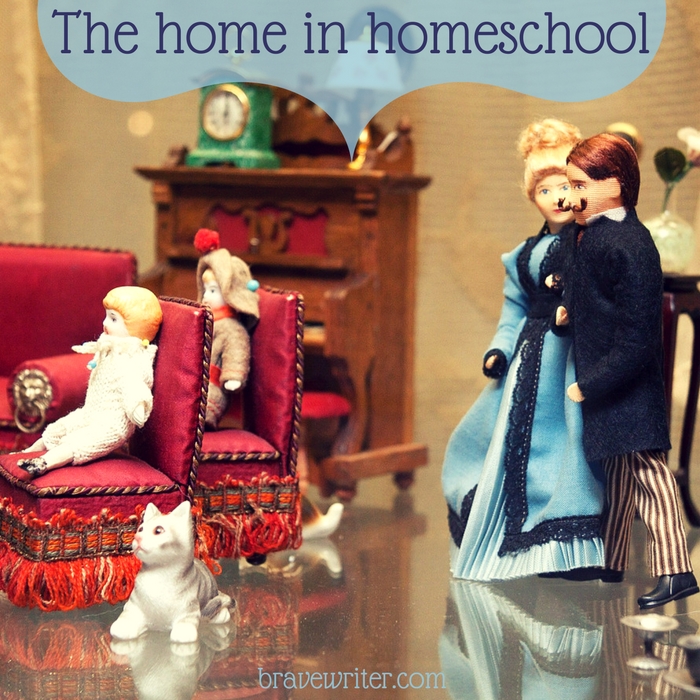
There are two kinds of “being home” that I want to explore in the blog. Today’s post focuses on the physical choice to be “home” more than away. For families with young kids (particularly if you’ve got kids under 12), cultivate a home life, in your house. For families with teens, be choosy. Outside activities are important, but consolidate when you can. If you’re in that awkward phase of life where you have some of each (little kids and big ones), your choices have to be that much more creative and deliberate. I’ve got a special section just for you further down.
The second kind of “being home” has to do with attitude—how do we treat each other when we are home as opposed to away? What does it look like/feel like to be educated in a home?
Choosing to be at home:
The first step in creating a better homeschool environment is to be home. Long stretches of time that go uninterrupted by orthodontists, trips to the tutor, vet appointments for the dog and shopping for food are essential to create a feeling of time and space to learn. One of the best bits of advice I received early on is to not make my doctor or dental appointments in the mornings. Just because I’m “home” doesn’t mean I’m free! If my kids were in a school building, I wouldn’t want to take them out for a check up. I’d wait until the afternoon. Likewise, my time at home is full and therefore I’m not available for appointments before noon, either. Better to schedule all such meetings after lunch. (If you have napping kids, then you have to wait until naps are done or let them nap in the car or stroller.)
Additionally, limit outside activities. We had a rule in our family of five kids that only two kids could be playing on a sports team at any given time. That meant that some of our kids couldn’t do their sport year-round. We had no prodigies so I didn’t have to weigh the merits of possible college scholarships against my decision, so your mileage may vary. But we discovered early on we could only support two weekend games and two sets of practices per week, per season. The same could be said for musical instruments, tutorials, co-ops, dance lessons and so on. When you have lots of kids, this becomes even more important. You do not want your youngest children to spend their early childhoods sipping Juicy Juice boxes in a car seat watching DVDs in the back of the van while they are schlepped along with hockey pads to the next practice!
When possible, hire people who will come to you or live within walking distance. The midwife I chose on my fifth birth traveled to me to do my check-ups. That’s the sole reason I picked her over my previous midwife. When my youngest decided she wanted piano lessons, I sent her across the street. Our piano teacher isn’t my favorite as far as technical skill to teach, but for the early stages, living two minutes from my doorstep outweighed all other concerns. We hired a violin teacher who drove to our house. We also hosted literature discussion groups, writing groups and study sessions so that we could stay home.
Carpool. Do activities that other families do so that you don’t have to do all the driving.
Save some activities until your kids can drive themselves. We didn’t have our kids get jobs outside the home until they could drive themselves. Three of them, however, earned money while at home babysitting and selling cookies in our neighborhood. Neither of these required me to drive anyone anywhere (except when one of them ran out of chocolate chips and forgot to tell me… grrrr!).
Consolidate activities. It’s better to have one long busy day of appointments than to have 30-60 minute trips three or four times per week that interrupt your time at home.
Make one day your inviolable day that you never go anywhere. Once you decide to do this, it will feel nearly impossible to make happen. You’ll find all kinds of reasons you can’t keep this commitment. Of course. Just like dieting or exercise. It’s a discipline. But just as you would clear your schedule to be available weekly for a co-op day, you can do the same in reverse. Make Tuesdays or Fridays (or whatever) the day you never leave the house. You always have the full day at home and are ready for it with good food, a lesson plan, fun TV programming to watch and no pressure to go anywhere. Even if you pull this off three Tuesdays of the month, that’s wonderful! You’ll be amazed at how jealously you guard that day once you commit to it. (Tuesday has traditionally been that day for me since we have co-op on Mondays which is all-day away from home.)
Teens: I’ve shared before that teens need to sense that they are getting out into the big world, evolving into young adults. Home can feel confining, redundant, risk-free. What felt safe and nurturing as a young child becomes confining and tedious past 13. These feelings are normal; they aren’t signs of rebellion or an inability to be happy. I recommend that your teens get involved in something much bigger than they are. One of my Brave Writer students became enamored of low cost, energy efficient housing and built eco-friendly homes in her backyard! Another started a fish breeding farm in the creek neighboring her house. These activities kept these students home, obviously. But home had become a bigger world!
And that’s the point. Home is either the refueling station between community college and aiding at the local elementary school three days a week, or it’s the means to pursuing a dream (writing a novel, inventing a language, crafting a quilt, remodeling the basement).
In our family, two of our teens joined a Shakespeare company that met downtown with professional actors and a wide variety of students once a week on the weekends with performances at the end of the year. I know teens who’ve built computers from scratch, are on high level sports teams, acted in plays, started parttime high school or junior college, worked for the first time, gone to art institutes, joined community or high school music programs, written for publication, and started businesses. Doing written narrations by themselves at the kitchen table is not enough for a teen’s education. And supervising the small children in the family is not a teen’s daily responsibility. We had the babies; they didn’t.
Teens need driver’s licenses and money. They need peers and challenges. And they need a home. That home is their anchor. They tack between feeling bold and anxious, mature and needing a parent. Home is the place where they can curl up and recharge.
Each teen is different so remember that some need more down time than others. You can monitor this by evaluating how well they manage emotionally. Paring down the outside activities can be one way to help them reconnect to themselves. But be cautious. Teens have a remarkable capacity to juggle many demands and some need that stimulation to become the competent people they want to be.
So what do you do if you have teens needing adventure and little kids needing a stable home routine? This is the trickiest period, but it’s important to be intentional. There are a couple ways to help your teens get out without sacrificing the little kids in the process (and there are ways to keep a nice, vibrant home life without forcing teens to sit home all day). Try some of these ideas and see how they work for you.
Commit to one big “out of the house”
project for your teen.
Support one big project (Shakespeare, biology class, refurbishing a car, All Star soccer). Pay for it, help get the teen to that project, show up for performances or whatever is required. Then, above that one big project, put the responsibility on your teen to make the other stuff happen. That means if it requires money, they earn it. If it requires rides, they coordinate (create the car-pooling, or drive themselves, or work it out with you so that it doesn’t interfere with your routine with the younger kids). They take responsibility for making the stuff they want… happen. That’s part of adventure, responsibility and risk. They choose to make their lives more interesting, richer.
Find one big project to work on at home.
This can be as sophisticated as constructing a language (I have one kid who did this) or as simple as becoming really good at World of Warcraft. It’s great if your teens have a goal that can be pursued at home: watching all the top AFI films, writing a novel, studying art history, planting a vegetable garden, rebuilding the engine of a car, building a website, learning photography. School work (the stuff that goes on the transcript) is necessary, but if it’s all that your teen does at home, home will quickly become a chore rather than a place your teen wants to be.
Protect your mornings.
Let your teens know that you need the mornings with your younger kids. That means you will resist being a ride between 8:00 and 11:00 every day. (If a teen needs a ride home from school or something routine like that and it doesn’t take you more than 15 minutes round trip to make it happen, then that’s not unreasonable… but be wary of interruptions that take a half hour or more.)
Triangle in other teen families.
It’s sure nice if your daughter and her best friend are both in the play together. Car-pooling! It’s great if a group of kids takes biology together so they can study, ride-share and have friends all at the same time.
Pass home responsibilities down
to the younger kids;
free your teens to do less at home.
Remember when your oldest was 10? You expected a lot (cleaning a bathroom, laundry, setting and clearing the table). But now that your youngest is 10, you still expect the 16 year old to do those chores while the 10 year old seems “too young.” Nonsense. Get your younger kids to do the chores and free the teen to study, have a social life, work a job, and pursue extra-curricular activities. This helps your teen want to be home, too.
Keep a computer in the family room.
This enables you to be with your youngers while your teens have a reason to leave their bedrooms.
Keeping the home in homeschool
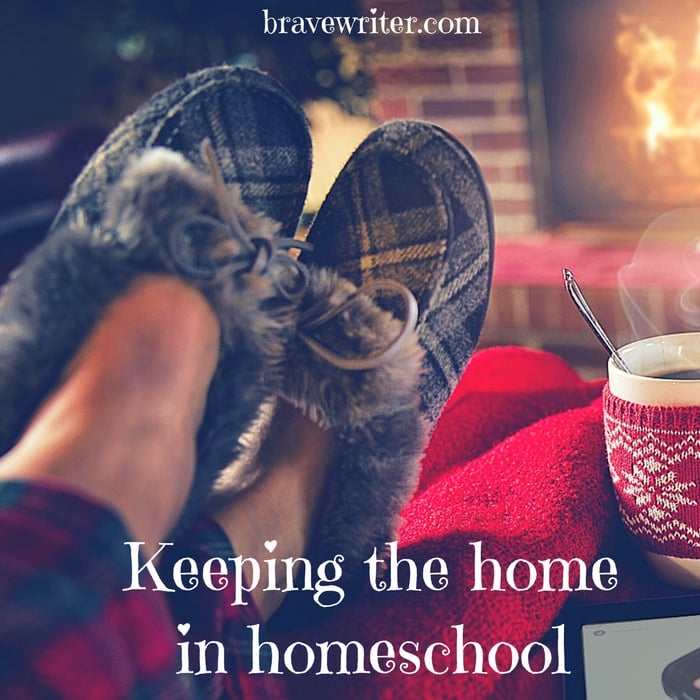
A friend shared her weekly schedule with me. Math tutoring on Wednesdays on one side of town; the twice-per-week biology class her daughter took on the other side of town; Celtic dance lessons; drawing class; piano for two kids; the weekly, day-long homeschool co-op; and three sports teams (with practices and games every week). She confessed to me that she was behind in writing. Of course, who wouldn’t be on that schedule? Then she made the funniest comment: “Wouldn’t it be great if you could get all the classes your kids needed in one building? Like you could get your math, biology, art, music and sports all in one place and not have to drive everywhere to go to them?”
As soon as the words came out of her mouth, we blurted together, “School. They call it school.”
And really, that’s the whole point of school. You get all the experts together to teach your kids all that they need/want to know, in one day, in one place. Parents take care of earning money and managing the home, kids go to a building to get an education. If you want that, school does it, efficiently and in some cases, well!
But most of us who home educate truly do not want that. We want something else.
We want a higher quality education.
We want relational connections with our kids and between our children. We want to have time for in-depth study. We want to take winter ski vacations and not miss “school.” We want our genius musicians to have plenty of time to practice or we want our star athletes to get enough sleep while they study and do their sports. We want to be the primary influences on our kids’ lives. We want to be the ones who see the lights go on in reading or fractions or Shakespeare. Or we hate the school district we live in, or can’t afford private schools.
It’s a tricky balance. We want to provide our kids with enriching experiences like field trips, tutors, co-ops, and violin lessons. We also want to consistently advance in the core subjects. In an effort to do it all, sometimes the “home” part of homeschool is lost. We bring school to the kitchen table and find it less and less inspired. So we add a bunch of outside activities and teachers, and the next thing you know: We’re car-schooling!
Back in the early days of home education, I read a long treatise on why parents ought to stay home, in the house, with their kids. The writer talked about rhythms and routines, modeling all kinds of life skills (plumbing and baking, creating a shopping list and sewing on buttons, filling the bird feeders and using the drill). She urged long sessions of reading aloud and leaving time for dress-ups and Legos, lying on a couch bored, face painting and knitting. She emphasized how busy-ness leads to a habit of breaking concentration, of not deeply investing in any one moment, project, or playtime because inside the child knows that that activity is about to be interrupted by another trip out the door.
With little kids, I had no trouble taking the “stay-at-home” advice to heart, though. We had one vehicle that I didn’t get to drive on week days, we didn’t own a TV, and the World Wide Web hadn’t been invented. So we stayed in, or we played on the front steps. But the pace of life, even with small kids, was slow. There were hours wasted on diaper changes, walks around the cul-de-sac, making muffins and taking naps. We read tons of picture books (took a laundry basket to the library and loaded up) and made play-doh from scratch.
And then, the world sped up. Cell phones, cable TV, Netflix (DVDs sent right to your door!), the Internet, two cars! The next thing I knew, the options of what I could do in and outside my tiny condominium with or for my kids flooded my life. Some of you only know homeschooling within that context of high-speed, 24/7 connections to All the Great Things to Do Every Day! You see and hear ads, you join email lists, you get calls from friends at any time of day. And of course, homeschooling itself has exploded in popularity in the last 20 years so there are more ways to spend your time and money than ever before (and plenty of advice that if you don’t do X, your child won’t be ready for Y!).
If you choose to homeschool,
let’s put the home before school.
What is home exactly?
Home. Cozy, pillows on a couch, blankets and a dog. Everyone who should be here is here. There’s a comfortable familiarity between us and I don’t have to figure out how to be. It’s a feeling that I’m not in a hurry or that I don’t have to be somewhere else. Home is what I come back to, not what I go out to. It’s the reset button, the safety net, the place where I know I can be my “self” just as I am and the people in my home will love and support me, will help me, will soothe me. Home is also where I can snack, nap, start a project and leave it out until it’s done. It’s where my secret stuff is hidden, it’s where all my materials are housed (I don’t have to cart anything around because it’s all in my home!). Home is a kitchen table where I eat family meals.
Home is also where I help myself to a drink or go to the bathroom when I want to. Home is a remote control, a telephone, a shower and a mailbox. Home is a hug from a mother and a game with my dad. Home is what I feel when I get off a plane in my city after a long trip and know my bed will feel better than any other bed in the whole world. Home is vanilla candles and cinnamon pine cones and tea in a thermos. Home is where dust bunnies grow and books litter the floor, where everyone watches American Idol and laughs together, and where I can hide in my bedroom to read a long book without having to stop. Some say you can take home with you. But I discovered years ago that home is actually a physical place, filled with people, memories and materials that help me to recharge so I can leave it again. When I lost my home (when my parents divorced in high school), I had to create a new one each new place I lived. Home matters. I can’t take it for granted.
We ask our homes to do double duty when we homeschool. We bring a memory of “school” from a building (that hard-working place) that was not home into our homes. We sometimes take the pressures of school as we remember it and add it into the mix of education at home. The safe space called home (that our kids intuitively know is supposed to be safe and peaceful) is now the competitive, demanding space of school. Grades and achievement happen “out there” for most people and home is the retreat. We’re asking our kids to marry the two, like oil stirred into water.
Awareness that we are, in fact, expecting our kids to work hard at home (when the spirit of home is slower, more restful, not driven to meet deadlines) is the first step. But the second step has to be changing how we understand education! If we truly believe that the competitiveness and the standardized lesson-plans, workbook style teaching of school are inferior to the tutorial-based educational style of homeschooling, then we need to stop hand-wringing about outcomes (progress) and imposing a schoolish format to the work we do with our kids!
For instance, moms call me asking how to help their kids with grammar or freewriting. A child doesn’t like it and isn’t doing it. The only idea the mom has to get it done is punitive (like withholding computer time, or shaming the child into it with prophecies of how horribly her chances for college are if she doesn’t master subordinate clauses, and so on).
I try to offer “homey” advice, instead.
Tell your child that you know grammar isn’t her thing, that it’s hard and tedious and she would rather not do it. Then make an offer of support that shows goodwill. Rub her shoulders before she starts, or get her a colored gel pen to write with, make her brownies or offer to pour her a cup of tea in her favorite mug. Let her do grammar by a roaring fire. Plug in her iPod and finish the page listening to a favorite band. Consider changing programs or doing grammar for a month on, a month off. Help grammar fit the mood of home.
I remind the mom: “You’re at home. Be homey. Support, nurture, be gentle.” It’s okay to be firm occasionally too (we all have to). But do it in the spirit of protecting the home environment as a safe, peaceful, nurturing space. Don’t undermine the power of home education through yelling, punishment, name-calling, harassment, withholding kindness, blaming, defining (telling your child he or she will not succeed in life unless…). Brainstorm solutions. Be your child’s ally. Always honor pain.
Don’t make an injured athlete play; don’t make a crying child learn.
Start with the premise that everyone in the home is on the same team, that all the resources you need to learn and grow together are in your house. Offer kindness and help as often as you can, even if the only thing you can think of in the moment is to acknowledge that the work is hard and you understand that your child doesn’t want to do it.













